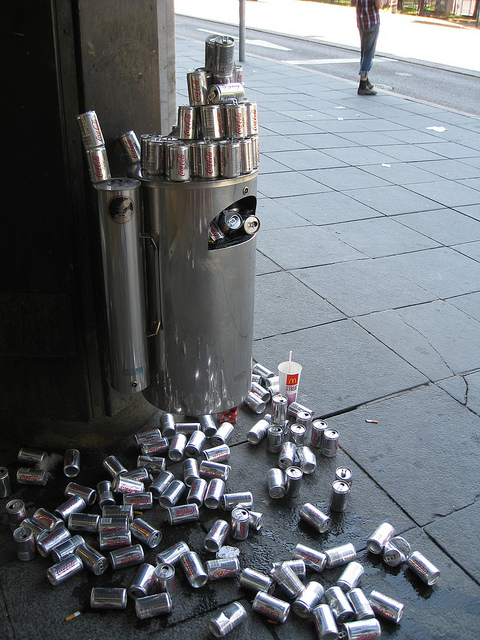Computer Networking Lecture Notes
2013 October 15 • Network Congestion Control
Outline
- Review and definitions.
- The congestion-control continuum.
- Prevention: network provisioning.
- Avoidance: admission control, throttling.
- Reaction: load shedding
The Territory
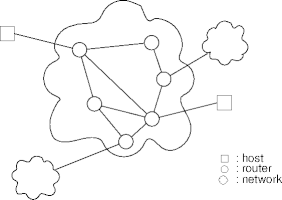
Network Resources
- Attached subnetworks treat the network (links + routers) as a resource.
- Bandwidth, routing, and so on.
- Network resources are finite and relatively static.
- Subnetwork resource demands are practically unbounded and dynamic.
- How can subnetwork demands be matched to network capabilities?
Resource Management
- Resource management can be proactive or reactive.
- Proactive management tries to manage demand to fit the resources.
- Reactive management tries to manage resources to fit the demand.
- Although it also tries to influence demand too.
- Congestion control is reactive management.
- Quality of service (QoS) is proactive management (next lecture).
Network Resources
- Routers are the network resource of interest.
- Time resources: router CPU, but also link bandwidth.
- Space resources: buffer space, but also routing table size.
- A simplified view, but a useful one.
Congestion
- Congestion occurs when demand (traffic) outstrips supply (resources).
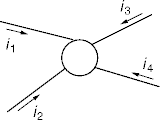
- The router can handle M bits/sec maximum.
- Congestion occurs when
\(\Sigma\)j ij bits/sec > M
- This is a first-cut definition.
More Congestion
- Link 4 can handle M4 bits/sec maximum.
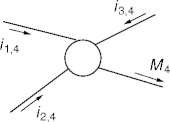
- Congestion occurs when \(\Sigma\)j ij, 4
bits/sec > M4.
- Even though \(\Sigma\)j ij, 4 bits/sec ≤ M.
Congestion Pictured
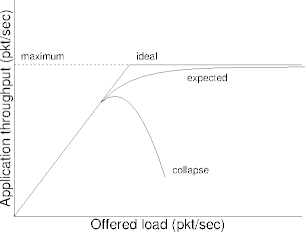
Controlling Congestion
- Network congestion control should
- Protect the network from congestion collapse but
- run the network as close to limits as possible.
- Higher utilization makes better economic sense.
- A continuum of network congestion control.
- From slower preventative techniques to faster reactive techniques.
Network Provisioning
- Network provisioning adds and upgrades resources to handle
traffic.
- Prevents congestion, but is slow to react.
- Expected traffic demands can be forecast, but not easily.
- Particularly in dynamic environments.
- Technologically-driven over-provisioning is helpful here.
- But Parkinson’s law.
Congestion Costs
- Congestion is a cost to the network and to its users.
- Routing algorithms are good at handling, and optimizing, costs.
- Condition edge and vertex weights (costs) on congestion.
- And use them in routing algorithms.
- The result is congestion-aware routing algorithms.
Example
- Congestion-aware routing algorithms
- have poor convergence properties, and
- can cause wild instabilities.

Evaluation
- Possible fixes for congestion-aware problems include
- multi-path routing
- dampened reaction to congestion changes.
- Congestion-aware routing algorithms used to be used in the Internet.
- Not a solution in itself, but helpful elsewhere.
An Analogy
- What do you do when you have more people than seats?
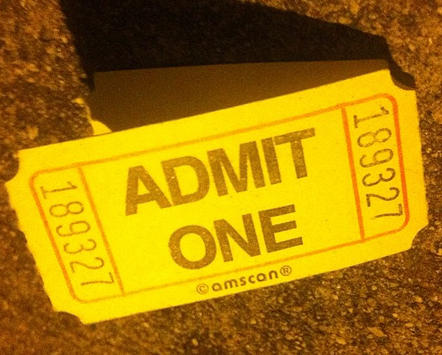
Admission Control
- Only admit traffic when the network can handle it without congestion.
- Easier for circuit-based networks than it is for datagram networks.
- But still not easy.
- Example: no dial tone on overloaded phone networks.
- The big questions in the Internet now are related to admission control.
Describing Traffic
- Traffic can be described by its average rate in bits/sec.
- But much traffic is bursty, or on-off variable.
- Think Web traffic over persistent connections.
- Traffic also has a shape, or instantaneous burst size in
bits/sec.
- The maximum rate.
Admission Decisions
- Fitting advertised rate + shape into the network can be tricky.
- Given applications with
- 100 kbit/sec average rate, and
- 1 mbit/sec burst rate
- how many applications fit in a 100 mbit/sec network?
Deciding Admissions
- (100 mbit/sec)/(100 kbit/app-sec) = 1000 applications.
- (100 mbit/sec)/(1 mbit/app-sec) = 100 applications.
- Deciding on average rates overcommits the network.
- Deciding on burst rates under-utilizes the network.
- And all this assumes the traffic parameters are accurate.
Congestion Awareness
- Congestion-aware routing is unstable for whole networks.
- But works well for routing specific circuits.
- Congestion is also more manageable, smaller and better behaved.
- Congestion-aware routes can more finely partition the network into congested and uncongested regions.
Recovering From Mistakes
- Admission control can err on the wrong side.
- And datagram services are harder to manage in the network.
- And networks are (should be) run close to congestion.
- What happens when congestion results?
- The network has failed, in some sense.
- It’s up to the senders to respond.
Traffic Throttling
- When too much traffic causes congestion, cut back (or throttle)
the traffic.
- A move from prevention and avoidance to reaction and mitigation.
- Any traffic-throttling scheme has two problems:
- Recognizing or anticipating congestion.
- Signaling congestion to the senders.
Recognizing Congestion
- Routers monitor network conditions and draw conclusions.
- Observable conditions include
- output link utilization,
- buffer or queue length, or
- resource exhaustion.
- Average utilization misses burstiness; resource exhaustion is too late.
- Average queue length works well.
Congestion Signaling
- A sender receiving congestion signals should throttle back
transmissions.
- By some amount for some time.
- Further signals, or their absence, determine future behavior.
- More signals, more throttling.
- Fewer or no signals, try for more capacity.
- How should these signals be conveyed?
Choke Packets
- A router nearing or in congestion sends choke packets back to
senders.
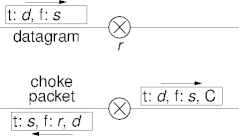
- Which sender does the router choke?
Sender Choice
- Choking the last-in packet sender may not help.
- That sender may not be a high-rate sender.
- Randomly pick a queued packet and choke its sender.

- High-rate senders queue many packets.
- Not perfect, but low overhead.
Aiding and Abeting
- Sending choke packets adds congestion.
- Congested routers flag packets encountering congestion anyway.
- Let the destination relay the congestion flag back to the sender in an ack.
- This is Explicit Congestion Notification (ECN).
- Implemented in DECNet (1980s), used in the Internet.
ECN Example
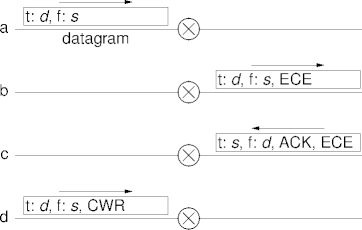
Long Fast Networks
- Seattle is using a fast network to send to Boston via Toronto.
- Toronto is getting congested, and uses choke packets or ECN.
- What happens?
- The Seattle-Toronto segment is filled with packets.
- The segment dumps all its packets into Toronto after Seattle is notified.
Network Action
- If the sender can’t help, the network has to.
- Each router forwarding a choke packet devotes extra buffer space to the exuberant flow.
- Congestion relief flows backwards to the sender, which then stems the
flow.
- Up-stream routers recover as the sender throttles.
- This is hop-by-hop backpressure.
The Last Resort
|
|
Load Shedding
- Last-resort congestion control throws packets on the floor.
- The important decision: what packets to drop?
- There are non-trivial decisions to be made.
- Random choice works, but are there better choices?
Dropping Knowledge
- Choice based on application-type can improve matters.
- Drop later (newer) packets in a file transfer.
- Drop earlier (older) packets in media streams.
- Wine vs milk.
- MPEG-encoded video packets.
- Chose based on packet-type too.
Sender Assistance
- The sender can mark packets as droppable or precious.
- There should be incentives for accurate marking.
- Too many precious packets can be penalized (by high cost, for example).
- A predominance of droppable packets can be rewarded (by improved priority, for example).
- This didn’t work in the Internet.
Definitive Signaling
- Sending signals in heterogeneous environments is tricky.
- Signals can be misinterpreted, misunderstood, or ignored.
- Dropped packets are a definitive congestion signal.
- But dropping packets in congestion is too late.
- Drop packets in near-congested conditions.
- An obvious and possibly timely signal.
Random Early Detection
- The Random Early Detection (RED) algorithm:
Drop packets at random in near-congestion conditions.
- This is a TCP-specific solution.
- Datagram based.
- TCP throttles on packet loss.
- Tuning RED parameters improves results.
- The Internet uses ECN with RED fall-back.
Summary
- Network congestion control drives the network up to but not into congestion.
- There is a continuum of congestion-control measures.
- From slow avoidance to fast recovery.
- Networks use several points in the continuum.
- Congestion problems and solutions are constantly shifting in response to technological and operational events.
Credits
- Admission (Found Object) by Tom Fassbender under a Creative Commons BY NC ND license.
- Overflowing trash bin by Matti Mattila under a Creative Commons BY NC SA license.
| This page last modified on 2012 October 18. |
